
ZOOM 80 WIDE DIX
INSTRUCTIONS
Before using your camera, read this manual carefully to ensure correct use.

ZOOM 80 WIDE DIX
INSTRUCTIONS
Before using your camera, read this manual carefully to ensure correct use.
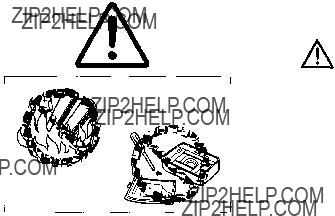
Thank you for purchasing an Olympus camera. Before
you start to use your new camera, please read these
instructions carefully to obtain optimum performance
and a longer service life from the unit.

Before using your camera, read this manual carefully
to ensure correct use.
We recommend that you take test shots to get accustomed to your camera before taking important
photographs.
MAIN FEATURES
Weatherproof.
Remote control (optional).
Versatile,
modes.
Symbols used in this manual:
Product shown in the illustrations may be slightly different from the unit.
3

PREPARATIONS
BASIC OPERATIONS
4

ADVANCED TECHNIQUES
CAMERA MAINTENANCE
5
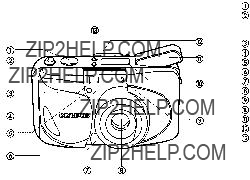
PREPARATIONS
NAMES AND FUNCTIONS OF PARTS
Shutter release button (p. 16)
Zoom lever (p. 21)
Zooms in ??? telephoto.
Zooms out ???
Vlewflnder
Strap eyelet
Light sensor
Lens barrier
Autotocus windows
Lens
Selftimer indicator
LCD panel(Date/timeindicator) (p. 8)
Flash
Selftimer/remote control button (p. 43/44)
Flash mode button (p. 33)
 Do not soil as this can cause blurred pictures. Wipe clean with a soft cloth.
Do not soil as this can cause blurred pictures. Wipe clean with a soft cloth.
6
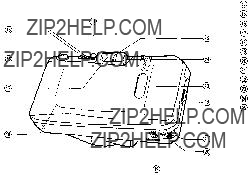
Diopter adjustment dial (p. 9) Quartzdate mode buttons (p. 46) Panorama switch (p. 29)
Viewfinder (p. 8)
Back cover
Tripod socket
Battery compartment cover
Back cover release (p. 17)
Film window
Green lamp
Orange lamp
7
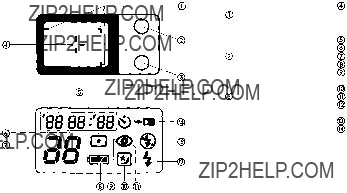
VIEWFINDER DISPLAY/LCD PANEL
Viewfinder Display
At a close distance, your
subject must be positioned within the
Orange lamp
Lights when the flash is ready to fire.
Blinks while the flash is recharging.
Green lamp
Lights when the subject is infocus.
Blinks when the subject is not in focus.
Autofocus mark
Position your subject within the autofocus mark.
LCD Panel
Date/time indicator Spot (p. 41)
Exposure counter (p. 19) Battery check (p. 14)
(Forced Activation) (p. 38)
Off (Flash Override) (p. 37) Selftimer/remote control (p. 43/44)
Note; The LCD panel does not actually display all indications
simultaneously as shown.
8

DIOPTER ADJUSTMENT
Turn the diopter adjustment dial until the viewfinder display becomes clear.
Turn to the right if you are
USINGTHESTRAP/SOFTCASE
Attach the strap as shown.
The soft case can also be carried on a belt.
9

OUTLINE OF OPERATIONS
Basic Shooting Procedures
Load a battery (p. 13).
Open the back cover (p. 17).
Load the film (p. 17).
(Use of ISO400film is recommended.)
Close the back cover. The film automatically advances to the first frame (p. 19).
10
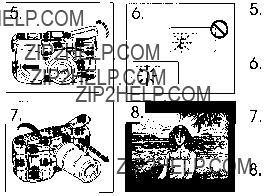
Open the lens barrier until you feel a click (p. 19).
Make sure the exposure counter on the
LCD panel reads  (p. 19).
(p. 19).
Press the zoom lever for telephoto or
Place the autofocus mark on the subject you want to photograph

Depress the shutter release button halfway to make sure the green lamp lights (p. 22).
Depress the shutter release button fully to take a picture (p. 23).
When the film reaches the end, it will automatically rewind (p. 28).
Open the back cover to remove the rewound film (p. 28).
12

LOADINGTHE BATTERY
Close the lens barrier. PushOPEN to
open the battery compartment cover
Insert the new battery correctly as
shown and close the battery
compartment cover tightly.
Use a 3 V lithium battery (DL 123A, CR123A, or equivalent.)
About 15 rolls of film can be used with one new battery. (p. 49)
Read "Battery Handling" on page 55.
13

CHECKINGTHEBATTERY
Open the lens barrier as shown until you feel a click. Check the remaining battery power.
Note: Keep spare battery on hand when going on a long trip or
a wedding or when using the camera in cold weather. Adjust
the data every time the battery is replaced.
14

POINTS TO REMEMBER
Hold the Camera Correctly.
Correct.
Hold the camera firmly with both hands while keeping elbows at sides to prevent the camera from shaking.
Correct.
In the vertical position, hold the camera
with its flash positioned at the top.
Incorrect.
Caution:
Keep your fingers and the strap away from the lens, autofocus windows and flash. (p. 6)
15

Proper Shutter Release.
Practice before loading the film.
Depress the shutter release button
halfway to lock the focus.
Make sure
The green lamp next to the viewfinder lights.
Depress the shutter release button fully to release the shutter and take the picture.
Cautions:
Press the shutter release button gently. Avoid shaking the camera when pressing the
16
shutter release button to prevent blurry pictures.

BASIC OPERATIONS
17
LOADINGTHE FILM
Slide the back cover release upward to
open the back cover.
Do not touch the inside of the camera, especially the lens. If there is dust or dirt on the lens, remove it with a blower brush.
Insert the film cartridge, making sure the film is lying flat.
Notes:
Use of ISO 400 film is recommended.
When using
automatically set.

Correct.
Make sure the film is lying flat before closing the back cover.
Incorrect.
Push the film cartridge gently as shown in (A) to position the film correctly. If the film is not lying flat as shown in (B), the film may not advance to
the first frame.
Caution:
18
Do not touch the plastic parts near the

Align the film leader with the mark  Then press the right side of the back cover and close it securely.
Then press the right side of the back cover and close it securely.
The film automatically advances to the first frame.
Make sure
The film does not overlap any of the positioning guides  shown on the left. Then close the back cover.
shown on the left. Then close the back cover.
Open the lens barrier until you feel a click.
Make sure
The exposure counter on the LCD panel reads
Note:
If blinks in the exposure counter, as shown on the left,
19
the film is improperly loaded. Reload the film.

TAKING PICTURES
Open the lens barrier until you feel a click.
Make sure
The lens extends slightly, the flash pops up, and the LCD panel activates.
When the flash is held down, the two indicators next to the viewfinder blink. The camera will not activate.
The display also goes out.
Release your finger from the flash to reactivate the camera.
20

Aim the camera at your subject. Use the zoom lever for telephoto or wide- angle photography.
How to Use the Zoom Lever
Telephoto:
Pull the lever to the "T" side to zoom in. Maximum telephoto focal length: 80 mm
Wide angle:
Push the lever to the "W" side to zoom out.
Maximum
21
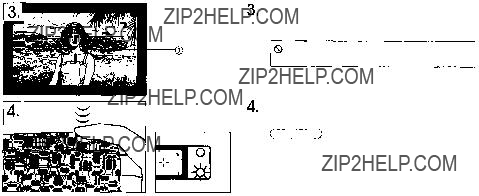
Position the autofocus mark on your subject.
 Autofocus mark
Autofocus mark
Do not look directly at the sun through the viewfinder.
Depress the shutter release button
halfway to adjust the focus.
Make sure
Focus has been correctly adjusted and the green lamp lights. Exposure also will be adjusted automatically.
22

Depress the shutter release button fully
to take the picture.
The film automatically advances to the next frame.
Working Distance
The focus range of the camera is 0.8 m (2.6 ft) to (infinity).
(infinity).
When the subject is closer than 0.8 m (2.6 ft), the shutter will not release, (The green lamp blinks.)
When the subject is extremely close to the
camera, the subject will be out of focus although the shutter releases.
23

Picture frame
Image area of picture at 0.8 m (2.6 ft)
The viewfinder's picture frame shows the area that can be shot for subjects at  . However, the picture area
. However, the picture area
will move lower in the viewfinder as you get closer to
the subject. At 0.8 m (2.6 ft), the shaded area is the
actual available image area. In this case, the subject should be positioned below the
marks.
24
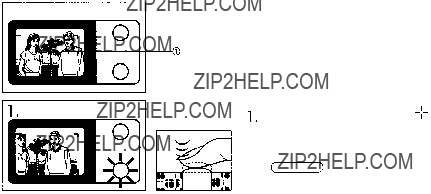
USINGTHE FOCUS LOCK
To avoid taking out of focus pictures
When the main subject is not within the
autofocus mark. Use the focus lock.
The autofocus mark must be positioned on the subject in
this case. The camera will focus on the background behind the subjects and the subjects will be out of focus.
 Autofocus mark
Autofocus mark
Position the autofocus mark on your subject and press the shutter release button halfway.
Make sure
The green lamp lights.
25


AFTER SHOOTING
Close the lens barrier slowly and
carefully. The lens and flash will retract
automatically.
Close the lens barrier completely.
The display goes out.
Caution:
Do not forcibly close the lens barrier as it will interfere with lens retraction.
27
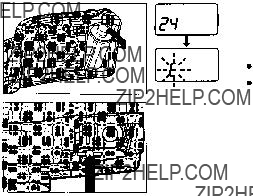
UNLOADINGTHEFILM
The camera automatically rewinds the film when you reach the end of a roll.
After the motor stops and  starts blinking on the LCD
starts blinking on the LCD
panel, open the back cover and remove the film.
Notes:
The number of exposures remaining decreases during winding.
The final number of exposures may sometimes exceed the number of exposures specified on the film.
Rewinding the film before the end of the roll
Press the
etc. Do not use an instrument with a sharp tip.
28
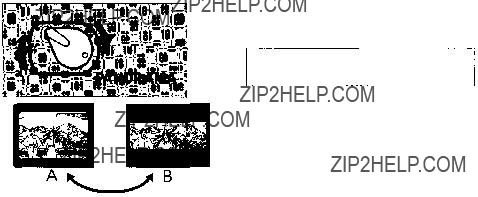
ADVANCED TECHNIQUES
29
TAKING PANORAMA PICTURES
Set the switch to PANORAMA to engage
the Panorama mode.
Set the switch back to the original position to restore the Standard mode.
Caution:
Do not touch the sliding PANORAMA borders inside the
camera when the back cover is open in the Panorama mode to avoid malfunction.
Note:
Always set the panorama switch to either end, not
midway between the two ends.
A.Viewfinder in the Standard mode.
B.Viewfinder in the Panorama mode.

At about 0.8 m (2.6 ft.) the shadedarea in
the illustration becomes the image area.
30

NOTES REGARDING PANORAMA FORMAT PRINTS
Availability of Panorama format film processing facilities varies according to area. We
recommend that you consult your local film processor or camera dealer before taking
pictures in the Panorama mode.
When pictures taken in the Panorama mode are printed in the standard size, black strips appear at top and bottom of prints as shown on the left.
Date or time can be imprinted even in the Panorama mode. Digits on Panorama prints are larger than on standard prints.
When you run out of the stickers for the cartridge, ask your nearest Olympus service
center.
31

PANORAMA
THIS ROLL CONTAINS
35MM STANDARD AND
PANORAMA FORMAT
NEGATIVES.
PLEASE PROCESS AND
PRINT AS 35MM
STANDARD FORMAT.
HOW TO GET PANORAMA PRINTS IN THE UNITED STATES
For Film Shot Only in Panorama Mode
Please affix the sticker A and be sure to ask specifically for Panorama prints from your processing lab.
For Film Shot in Both Panorama and
Standard Modes
It is possible to have all pictures printed in standard format. In this case, the sticker B is required. When
you receive your prints, the pictures taken in the Panorama mode can be identified by the black
strips at the top and bottom. If you wish, you can
have these pictures reprinted in Panorama format by taking the respective negatives to your processing
lab.
These prints may appear slightly overexposed.
However, they will be properly exposed for
32

USINGTHE FLASH MODES
This camera has six flash modes. Select the
flash mode according to your shooting
conditions and needs.
How to select the flash mode:
As you press the FLASH mode button, the mode
switches as shown on p. 34. The selected flash
mode is displayed on the LCD panel.
Do not discharge flash too close to
eyes of people or animals.
33


AUTO FLASH
The flash fires automatically in the dark and in backlit conditions.
Make sure
The orange lamp in the upper right of the viewfinder
lights when the shutter release button is depressed
halfway.
Notes:
When the orange lamp is blinking, the flash is being recharged and the shutter won't release. Release your finger from the shutter release button, and wait for several seconds. Maximum distance is about 70% when using positive color film.
 Flash Working Range (with color negative film)
Flash Working Range (with color negative film)


Significantly reduces the phenomenon of
Inthe  flash mode, the camera will fire a series of
flash mode, the camera will fire a series of
makes the subject's pupils contract, significantly
reducing
is the same as the Auto Flash mode.
Is not looking at the flash from the right front.
Is not watching the
Is too far from the camera.
The effectiveness of
on the individual characteristics of subjects.
IMPORTANT: Be sure to hold the camera still until the
shutter releases. It takes approximately one second.
36

 OFF (Flash Override)
OFF (Flash Override)
When you don't want the flash to fire even in the dark or when you want to shoot such subjects as fireworks.
In the
twilight or night scenes.
Note: Since a slow shutter speed (down to 4 seconds) is
automatically selected in
37


When you want to fire the flash every shot.
In the  Flash mode, the flash fires regardless of
Flash mode, the flash fires regardless of
available light. For example, this mode can be used to brighten up a subject's shaded face or under artificial
lighting such as backlight or fluorescent light. Use this mode within the flash working range (p. 35).
It may be hard to work under excessively bright light.
Closing the lens barrier restores the Auto Flash mode.
38

 NIGHT SCENE FLASH
NIGHT SCENE FLASH
Both people and night scenes can be clearly photographed in this mode.
When taking pictures of people with a night background, this mode produces clear images of both.
Notes:
Since a slow shutter speed (down to 4 seconds) is
automatically selected in
The Spot mode cannot be used while the Night
Scene Flash mode is being used.
Closing the lens barrier restores the Auto Flash
mode.
39

 RED-EYE
RED-EYE
FLASH MODE
Significantly reduces the
photographed against a night background.
The camera will fire a series of
contract, significantly reducing the
for the
Read the precautionary remarks in
39). The Spot mode cannot be used while the Red- eye Reducing Night Scene Flash mode is being used.
Note: When the lens barrier is closed, the
40
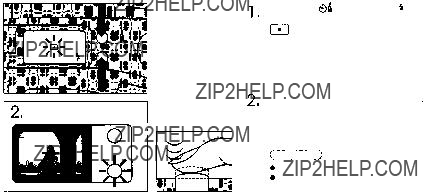
 SPOT MODE
SPOT MODE
To focus and set the exposure for a selected area.
same time.
is displayed on the LCD panel.
Press the  and the flash mode buttons at the same time or close the lens barrier to
and the flash mode buttons at the same time or close the lens barrier to
cancel the Spot mode.
subject, and press the shutter release button halfway.

Reposition your subject in the picture
frame while keeping the shutter release button depressed halfway. Then press
the shutter release button fully.
Focus and exposure can be adjusted at
different points from the autofocus frame using the Spot mode.
The use of the Spot mode is recommended in the following cases:
When there is an object in front of the main
subject.
When the subject is on the edge of the frame.
When the background is brighter than the subject (the subject is backlit).
42

 is displayed on the LCD panel.
is displayed on the LCD panel.
Make sure
The camera is fixed firmly on a tripod or other support.
Aim at your subject, and press the
shutter release button.
10 sec.: Selftimer indicator lights
2 sec.: Blinks
The shutter will be released about 12 seconds
after pressing the shutter release button.
Notes:
The focus and exposure will be locked when the shutter release button is depressed halfway.
The selftimer is disengaged when the shutter is released.
To cancel the selftimer after it has been activated, press the

 REMOTE CONTROL (optional)
REMOTE CONTROL (optional)
Press the  button.
button.  isdisplayed on the LCD panel.
isdisplayed on the LCD panel.
After shooting, press the  button again to cancel the Selftimer/Remote Control mode. Remote control operation is canceled automatically when not in use for more than 20 minutes.
button again to cancel the Selftimer/Remote Control mode. Remote control operation is canceled automatically when not in use for more than 20 minutes.
44

Aim the remote control at the camera, and press the button. The shutter will be released after about 3 seconds.
Notes:
Use the remote control within the range shown at left. The camera will focus on the subject directly in front of it.
The remote control may not work when the subject is
backlit. In this case, use the selftimer.
The remote control may not work when there is inverted fluorescent light near the camera.
45

CORRECTING THE DATA
Press the MODE button for two seconds
or longer.
The year indication will start blinking.
Press the SET button to correct the year.
If you press the button once, the number on the display will advance by 1. And if you keep it pressed, the numbers will run in rapid succession.
46

Press the MODE button again.
The month indication will start blinking.
Repeat steps 2 and 3 to set the hour
and minutes.
Note: As you press the mode button, the blinking indication
changes in the order of year, month, day, hour, and minute. The data correction will be finished when the mode button is pressed

PRINTING THE DATE AND TIME
Choose the desired mode with the MODE button.
The mode will switch in the described order by pressing the MODE button.
The quartzdate uses the same power source as the main unit. Make sure to correct the data after the battery is replaced.
The data is imprinted in the lower right of the picture. If
there is something whitish or tinged with orange where
the data is imprinted, the data may be difficult to read. The data may not be imprinted correctly on the frame(s) after the specified final exposure of the film.
48
CAMERA MAINTENANCE
QUESTIONS AND ANSWERS
Q: How long will the battery last?
A:A new 3V lithium battery will last for roughly 15 rolls of
Q:Why does the flash get hot?
A:If the flash is used continuously, it may become hot. If this happens, stop using the camera for a while.
Q:Can I use infrared film?
A:No, you cannot.
Q:How should I clean the lens?
A:Wipe the lens gently with lens cleaning tissue that has been moistened with a small amount of lens cleaning fluid.
Q:Can I mount a filter or hood?
A: No, you cannot.
Q: What should I do when both the orange and green
lamps are blinking and the camera doesn't work?
A:Release your finger from the flash. The camera will reactivate.
49

50
CARE AND STORAGE
Do not leave the camera in any place exposed to excessive heat, humidity, or direct sunlight ??? for example, in a car or on the beach.
Do not expose the camera to formalin or naphthalene.
If the camera gets wet, wipe it with a dry towel as soon as possible. The salt in seawater can be especially damaging.
Do not use organic solvents, such as alcohol or paint thinner when cleaning the camera.
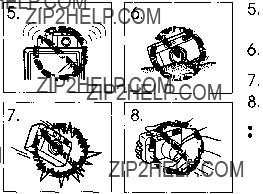
Do not leave the camera on or near a
television, refrigerator, or other appliance with a magnetic field.
Do not expose the camera to dust or sand as this could cause serious damage.
Do not shake or shock the camera.
Do not apply excessive force to the zoom
lens.
Keep the camera in a
Do not expose the camera to extreme heat (over 40??C/104??F) or to extreme cold (below
51

When transporting the camera from a cold place to a warm place or in the event of a sudden temperature change, put the camera into a plastic bag. This allows the camera's
temperature to change slowly. Once the camera has
adjusted to the new temperature, you can remove it from the
bag and use it.
Keep your hair, hands, strap, etc. away from the autofocus window, lens, AE sensor and flash.
Avoid leaving the camera unused for long periods of time. This can cause mold to grow on the camera as well as other
problems. Try to press the shutter release button and check the operation of camera before use.
Some airport
This camera is controlled by a microcomputer. Problems with the microcomputer can affect or stop camera operation. If
this happens, remove the batteries, then reload them and try
the camera again. Strong electrical fields can also interfere
with the operation of this camera so try to avoid places or objects that generate such fields.
This camera is not suitable for professional use or for use
under severe conditions.
52

CARING FOR YOUR WEATHERPROOF CAMERA
This camera is weatherproof; however, it is not designed for underwater use. Please
note the following warnings and use the
camera correctly.
The camera can withstand splashing water
(e.g., seaside, poolside, etc.)
The camera can be used in rain.
And in snow.
Do not wash the camera.
53

Do not submerge the camera or attempt to take pictures underwater.

BATTERY HANDLING
NOTES
When the camera is not used for an
extended period of time, remove the battery. Keep a spare battery on hand when going on
a long trip or to a cold area.
Sweat, oil, and so on can prevent a battery's
terminals from making electrical contact. To
avoid this, wipe both terminals before loading a battery.
Dispose of used batteries as general waste according to local regulations.
55

WARNINGS
NEVER TRY TO DISASSEMBLE, RECHARGE, OR
BATTERY TO EXCESSIVE HEAT OR OPEN
FLAMES.
KEEP THE BATTERY OUT OF THE REACH OF
CHILDREN. IF A CHILD SWALLOWS A BATTERY,
CONTACT A DOCTOR IMMEDIATELY.
USE ONE 3V LITHIUM BATTERY (DL123A OR
CR123A). NEVER TRY TO DISASSEMBLE OR
MODIFY ANY BATTERY OR BATTERY PACK FOR
USE IN THIS CAMERA.
56

REMOTE CONTROL (optional) HANDLING
Keep the remote control out of the reach of
children. If a child swallows the remote
control, contact a physician immediately. Never try to disassemble the remote control. Never expose the remote control to excessive heat or open flame.
57

TROUBLESHOOTING

The LCD display goes off suddenly.
If you don't use the camera, the LCD goes off after four and half minutes.
 Close the lens barrier and open it again or operate
Close the lens barrier and open it again or operate
the zoom lever to turn the LCD back on. In addition, the
power is turned off automatically after 4.5 hours. When the camera is not in use, try to keep the lens barrier closed.
The shutter doesn't release when the remote control's button is pressed.
 The remote control hasn't been used in the 20 minutes since the Selftimer/Remote Control mode
The remote control hasn't been used in the 20 minutes since the Selftimer/Remote Control mode
was engaged, causing the LCD panel to turn off.  Press the zoom lever. The LCD will light. Then press the Selftimer/Remote button again.
Press the zoom lever. The LCD will light. Then press the Selftimer/Remote button again.
59

The green lamp blinks, and the shutter release button
will not release.
The camera is closer than 0.8 m (2.6 ft) to the
subject.
 Move the camera back to distance more than
Move the camera back to distance more than
0.8 m (2.6 ft) from the subject. (p. 23)
The orange lamp blinks, and the shutter will not
release.
The flash has not been recharged yet.  Remove your finger from the shutter release
Remove your finger from the shutter release
button and wait for several seconds until the flash is recharged before shooting. (p. 35)
The flash does not fire, even in the dark.
The flash mode is set to Off.
 Set it to a mode other than Off. (p. 37)
Set it to a mode other than Off. (p. 37)
High sensitivity film is being used.
 Set the flash mode to
Set the flash mode to
60

The viewfinder is out of focus.
Diopter dial is not adjusted.
 Adjust the diopter dial until image is clear. (p. 9)
Adjust the diopter dial until image is clear. (p. 9)
PROBLEMS WITH PRINTED PICTURES
The picture is out of focus.
The camera moved when the shutter release button was pressed.
 Hold the camera correctly and press the shutter
Hold the camera correctly and press the shutter
release button gently. (p. 15)
The subject was not within the viewfinder's
autofocus mark.
 Position the subject in the center of the autofocus mark. (p. 22)
Position the subject in the center of the autofocus mark. (p. 22)
The lens and autofocus windows were dirty.  Clean the lens and autofocus windows.
Clean the lens and autofocus windows.
61

The autofocus window was blocked, such as by a finger.
 Hold the camera correctly, keeping your fingers clear of the autofocus windows. (p. 15)
Hold the camera correctly, keeping your fingers clear of the autofocus windows. (p. 15)
The subject was closer than the minimum working distance to the lens (0.8 m/2.6 ft).
Shoot from more than 0.8 m (2.6 ft) away from
the subject. (p. 23)
When using the selftimer, the shutter release
button was pressed while standing right in front of
the camera.
 Do not stand in front of the camera. Press the shutter release button while looking through the viewfinder. (p. 43)
Do not stand in front of the camera. Press the shutter release button while looking through the viewfinder. (p. 43)
62

The autofocus didn't work correctly. There are
some subjects that are difficult for the autofocus to
lock on. These include: glossy or reflective surfaces, black objects, subjects behind glass or wire mesh, flames and smoke, excessively bright light within the picture area.
First focus on an object at the same distance as the desired subject. Then aim at the desired subject and press the shutter release button.
(p. 42)
The picture is too dark.
 The flash was blocked, (e.g. by a finger).
The flash was blocked, (e.g. by a finger).
 Hold the camera correctly, keeping your fingers clear of the flash. (p. 15)
Hold the camera correctly, keeping your fingers clear of the flash. (p. 15)
 The subject was out of the working range of the flash.
The subject was out of the working range of the flash.  Shoot within the flash working range. (p. 35)
Shoot within the flash working range. (p. 35)
The flash mode was set to Off.
 Check the flash mode before shooting. (p. 33)
Check the flash mode before shooting. (p. 33)
63

The data has not been printed (or looks faded). The data mode was set to no data
 Change the data mode to another setting. (p. 48)
Change the data mode to another setting. (p. 48)
There is a bright color like white, orange, or yellow in the area of the picture where the data is printed.
 Avoid bright colors in the lower right corner of
Avoid bright colors in the lower right corner of
your photo compositions. (p. 48)
The picture was taken with
 Do not use
Do not use
The color of a picture taken indoors is abnormal.
The color of the room lighting affected the picture.  Set the flash to
Set the flash to
64

Selftimer: Electronic selftimer
Remote control (optional): Infrared remote control unit with
Film speed range: Automatic setting with
and film with less than ISO 50, film speed is set
to ISO 100.
Film loading: Automatic loading. (Automatically advances to first frame when camera back cover
is closed.)
Film advance: Automatic film winding.
Film rewind: Automatic film rewind (automatic rewind activation at end of film, automatic rewind stop).
Rewind possible at any point with rewind button.
66

Flash:
angle ??? 0.8 ~ 8.8 m (2.6 ~ 28.9 ft), Telephoto ???
0.8 ~ 4.6 m (2.6 ~ 15.1 ft) with ISO 400 color
negative film.
Flash modes: Auto (automatic flash activation in low light and backlight, 
flash with slowest shutter speed of 4 sec.),  Fill-
Fill-
In (forced activation), Night Scene (for night scenes with slowest shutter speed of 4 sec. other functions operate the same as in Auto),
Battery check: Displayed on LCD panel.
67
Weatherproof: IEC Standard publication 529.
Classification of degrees of protection provided by enclosures. Degree of protection indicated by second characteristics numeral 4.
Short description: Protected against splashing water.
Definition: Water splashed against enclosure from any direction shall have no harmful effect.
Test for second numeral 4: Equipment is sprayed from
all practical directions. Water pressure is adjusted to give delivery rate of 10 lit./min. Test
duration shall be 1 min. per m2 of calculated surface area of enclosure with minimum duration of 5 min.
Power source: 3 V lithium battery (DL123A/CR123A)
Dimensions: 120 (W) x 64 (H) x 49 (D) mm (4.7 x 2.5 x 1.9 in) (without grip and other protrusions).
Weight: 255 g (9.0 oz) (without battery)
68
SPECIFICATIONS FOR DATE UNIT
Imprinting direction: Data imprinted onto film from lens side.
Data coding: No data,
year,
panel.
Film speed setting: Automatic film speed setting.
Automatic calendar system: Up to year 2030.
Power source: Ordinarily used with camera body.

OLYMPUSOPTICALCO.,LTD.
OLYMPUS AMERICA INC.
Two Corporate Center Drive, Melville, NY
OLYMPUS OPTICAL CO. (EUROPA) GMBH.
(Premises/Goods delivery) Wendenstrasse
OLYMPUSSINGAPORE PTE. LTD.
491B River Valley Road,
Tel.
This device complies with part 15 of the FCC Rules. Operation is subject
to the conditions that this device does not cause harmful interference.
This Class B digital apparatus meets all requirements of the Canadian Interference - Causing Equipment Regulations. Cet appareil num??rique de la classe B respecte toutes les exigences du R??glement sur le mat??riel brouilleur du Canada.